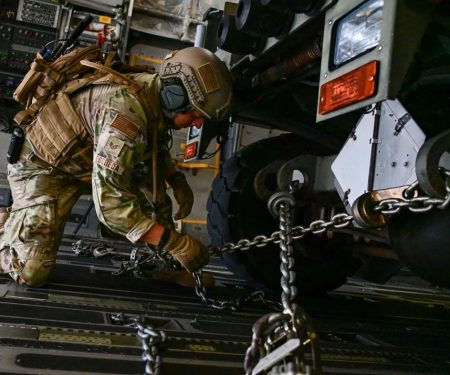Future Airmen and Guardians Will Now Carry Practice Rifles Throughout Boot Camp
Editorial: An Unfulfilled Offset Strategy
PHOTOS: Air Force Football Honors AFSOC with New Uniforms
Radar Sweep
Ukraine’s Surprise Attack Forces Russia to Divert Forces in Response
Since its surprise incursion into Russia more than a week ago, Ukraine has steadily gained ground, saying it advanced even deeper into Russian territory on Aug. 14. ... And now Moscow has begun withdrawing some troops from Ukraine in an effort to repel Kyiv’s offensive into western Russia, according to U.S. and Ukrainian officials, an indication that the surprise attack is forcing Moscow to change its battle plans in Ukraine.
Ukraine Hammers Russian Airbases as Kyiv’s Incursion Triggers Panic
Kyiv’s forces continued their incursion into Russian territory Aug. 12, targeting airbases, sending a barrage of missiles and drones into the Kursk region and triggering a state of emergency in the entire Belgorod region. The Russian Ministry of Defense said in a statement that dozens of Ukrainian drones were shot down across the southwest of the country over the regions of Kursk, Belgorod, Voronezh, Volgograd, Bryansk, Orel, Rostov, and Nizhny Novgorod. ... The Nizhny Novgorod region is home to Savasleyka airbase, where Moscow's forces house aircraft equipped with the hypersonic Kinzhal missiles.
SPONSORED: Hurlburt Saves $1.5 Million Annually Through Energy Resilient Upgrades
Air Force Special Operations Command, headquartered at Hurlburt Field, Fla., is tackling grid stability issues through a self-funding $22.6 million Energy Savings Performance Contract (ESPC) with Schneider Electric. The project is reported to save the Air Force $1.5 million annually during the 20-plus year contract.
Two Programs Suggest the Pentagon Is Getting Better at Buying Technology
Two new reports suggest that the Pentagon may have finally learned how to buy technology at lower cost quickly, at least when it comes to AI-driven capabilities. One report looks at the Maven Smart System, or MSS, part of Maven, a system for rapidly analyzing and sharing intelligence. ... A second report published last week by CSIS highlights the U.S. Air Force’s Collaborative Combat Aircraft program—essentially an armed drone battle-buddy for fighter jets—as a potential way forward for future aircraft procurement.
Second Replicator Tranche to Include Anduril’s Autonomous Underwater Drones
Pentagon leadership selected Anduril’s Dive-LD autonomous underwater vehicles as part of the second tranche of capabilities to be quickly mass produced via the high-profile modernization effort known as Replicator, multiple sources told DefenseScoop this week.
White House Advisory Group Blasts US Government, DOD Inattention to GPS Woes
The independent White House advisory group on GPS is taking the US government to task for failing to adequately address increased risks of interference with the Pentagon owned satellites, and for lack of progress in finding alternative positioning, navigation, and timing (PNT) systems—suggesting that control of GPS functions should lie outside the Defense Department.
Northrop Grumman Continues to Trim Space Workforce in California
U.S. defense contractor Northrop Grumman plans to lay off 550 full-time employees at its space business facilities in Redondo Beach and Manhattan Beach, California, marking another round of job cuts in the sector.
Iraq Boosts Helicopter Fleet Ahead of Pending US Troops Withdrawal
Iraq is beefing up its rotorcraft fleet with a new planned purchase of French helos, a move experts said could take on new significance amid discussion of American troops’ eventual exit from the Middle Eastern nation.
ANALYSIS: Did China Just Demote Its Defense Ministry?
Among the most significant personnel changes of the Chinese Communist Party’s recent Third Plenum meeting are two that didn’t happen: Adm. Dong Jun, the country’s defense minister, was neither added to the Central Military Commission nor appointed a State Councilor. This is an apparent demotion for the defense ministry, and could complicate the military-to-military relationship between China and the United States, write Shanshan Mei, a political scientist at RAND, and retired Army Lt. Col. Dennis J. Blasko, a former military intelligence officer and foreign area officer specializing in China.
Panavia Tornado Swing-Wing Combat Jet’s 10 Most Unusual Variants
Half a century ago on Aug. 14, the first prototype of the Panavia Tornado, aircraft P-01, was recorded taking to the skies at Manching in West Germany, with test pilots Paul Millet from British Aerospace and Nils Meister of Messerschmitt-Bölkow-Blohm (MBB) at the controls.




